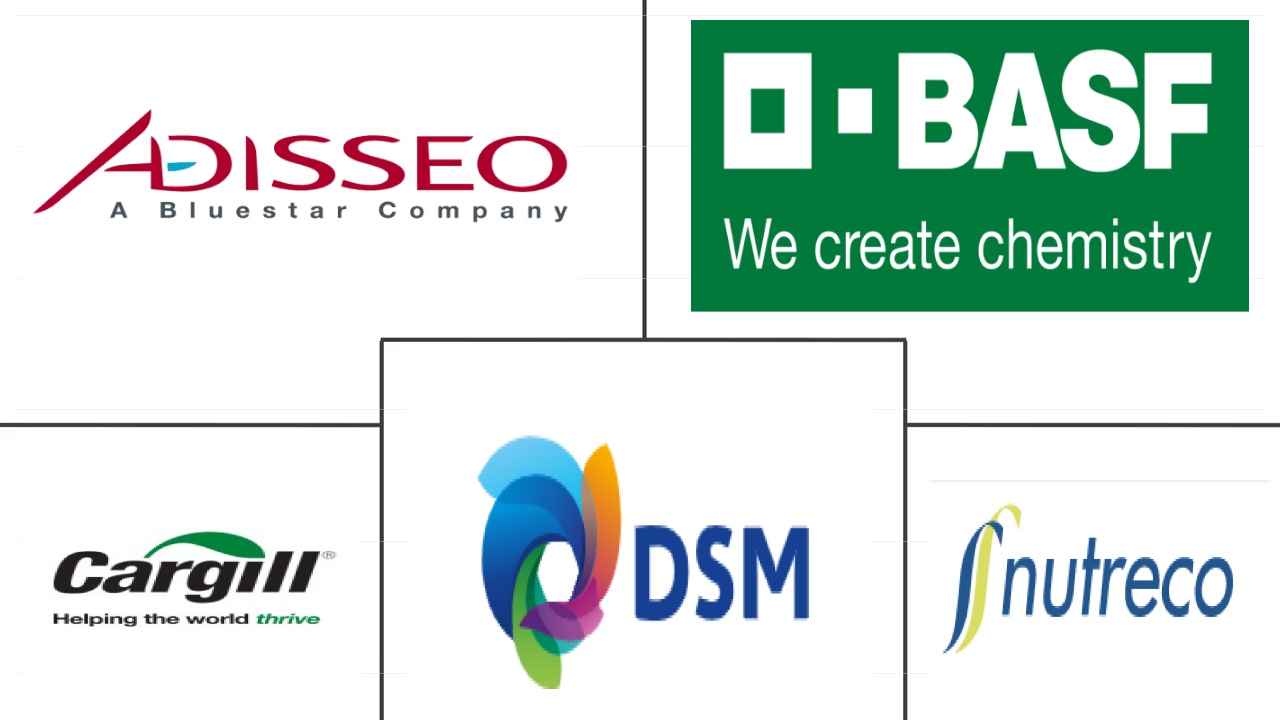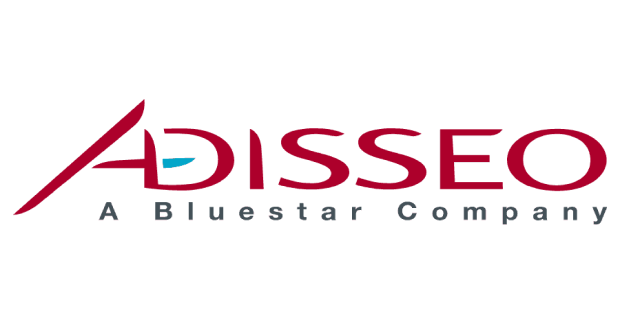Market Size of china feed additives Industry
| Icons | Lable | Value |
|---|---|---|
|
|
Study Period | 2017 - 2029 |
|
|
Market Size (2024) | USD 4.78 Billion |
|
|
Market Size (2029) | USD 6.09 Billion |
|
|
Largest Share by Additive | Amino Acids |
|
|
CAGR (2024 - 2029) | 4.94 % |
|
|
Fastest Growing by Additive | Antioxidants |
|
|
Market Concentration | Low |
Major Players |
||

|
||
|
*Disclaimer: Major Players sorted in no particular order |
China Feed Additives Market Analysis
The China Feed Additives Market size is estimated at 4.78 billion USD in 2024, and is expected to reach 6.09 billion USD by 2029, growing at a CAGR of 4.94% during the forecast period (2024-2029).
4.78 Billion
Market Size in 2024 (USD)
6.09 Billion
Market Size in 2029 (USD)
6.16 %
CAGR (2017-2023)
4.94 %
CAGR (2024-2029)
Largest Market by Additive
16.65 %
value share, Amino Acids, 2023
The segment for amino acids is the largest due to the increase in the demand for meat, the increase in awareness to balance the gut pH, and the reduction in the occurrence of infections.
Largest Market by Animal
48.45 %
value share, Poultry, 2023
Poultry is the largest animal segment due to the rising demand for the consumption of poultry products and the increase in poultry population by 2% during 2020-2022.
Fastest-growing Market by Additive
5.73 %
Projected CAGR, Antioxidants, 2024-2029
The demand for antioxidants is growing at the fastest rate due to the increase in the demand for poultry feed and the shelf life of animal feed during storage.
Fastest-growing Market by Animal
5.86 %
Projected CAGR, Ruminants, 2024-2029
Ruminants comprise the fastest-growing segment in the market due to China being a major producer of feed for beef cattle and an increase in awareness about the health benefits.
Leading Market Player
11.34 %
market share, Adisseo, 2022

Adisseo is a market leader. It has a joint venture with Calysta Inc. to construct a new production facility with an annual capacity of 18,143 metric tons of feed additives.
- The Chinese feed additives market witnessed significant changes in 2020 due to the COVID-19 pandemic. In 2022, amino acids, binders, minerals, probiotics, and prebiotics emerged as the major feed additive types, accounting for nearly 59% of the market. Lysine and methionine, in particular, were popularly used in commercial cultivation due to their benefits, such as improved gut health and easy digestion in animals, making them the largest contributors to the feed amino acids market.
- Synthetic binders held the largest share of the Chinese binders market in 2022, accounting for 70.4% of the total market value. They serve not only in pellet feed but also help in preventing diseases by improving digestion and nutrition intake in animals. Among different animal types, poultry birds dominated the feed additives market, constituting 48.1% of the market, followed by swine and aquaculture species. The high feed intake and the higher feed production of poultry birds, which exceeded 0.13 billion metric ton in 2022, were the main factors for their higher market share.
- Antioxidants emerged as the fastest-growing segment in the Chinese feed additives market, with a CAGR of 5.7% during the forecast period. They play a crucial role in prolonging the shelf life of animal feeds, with citric acid having importance in reducing the colonization of pathogens and limiting the production of toxic metabolites while improving the availability of protein, Ca, P, Mg, and Zn.
- With the increase in the commercial cultivation of animals, the benefits of feed additives such as increased shelf life of feed, and the importance of feed additives in animal nutrition, the demand for feed additives is anticipated to register a CAGR of 4.9% during the forecast period.
China Feed Additives Industry Segmentation
Acidifiers, Amino Acids, Antibiotics, Antioxidants, Binders, Enzymes, Flavors & Sweeteners, Minerals, Mycotoxin Detoxifiers, Phytogenics, Pigments, Prebiotics, Probiotics, Vitamins, Yeast are covered as segments by Additive. Aquaculture, Poultry, Ruminants, Swine are covered as segments by Animal.
- The Chinese feed additives market witnessed significant changes in 2020 due to the COVID-19 pandemic. In 2022, amino acids, binders, minerals, probiotics, and prebiotics emerged as the major feed additive types, accounting for nearly 59% of the market. Lysine and methionine, in particular, were popularly used in commercial cultivation due to their benefits, such as improved gut health and easy digestion in animals, making them the largest contributors to the feed amino acids market.
- Synthetic binders held the largest share of the Chinese binders market in 2022, accounting for 70.4% of the total market value. They serve not only in pellet feed but also help in preventing diseases by improving digestion and nutrition intake in animals. Among different animal types, poultry birds dominated the feed additives market, constituting 48.1% of the market, followed by swine and aquaculture species. The high feed intake and the higher feed production of poultry birds, which exceeded 0.13 billion metric ton in 2022, were the main factors for their higher market share.
- Antioxidants emerged as the fastest-growing segment in the Chinese feed additives market, with a CAGR of 5.7% during the forecast period. They play a crucial role in prolonging the shelf life of animal feeds, with citric acid having importance in reducing the colonization of pathogens and limiting the production of toxic metabolites while improving the availability of protein, Ca, P, Mg, and Zn.
- With the increase in the commercial cultivation of animals, the benefits of feed additives such as increased shelf life of feed, and the importance of feed additives in animal nutrition, the demand for feed additives is anticipated to register a CAGR of 4.9% during the forecast period.
| Additive | |||||||||||
| |||||||||||
| |||||||||||
| |||||||||||
| |||||||||||
| |||||||||||
| |||||||||||
| |||||||||||
| |||||||||||
| |||||||||||
| |||||||||||
| |||||||||||
| |||||||||||
| |||||||||||
| |||||||||||
|
| Animal | |||||||
| |||||||
| |||||||
| |||||||
| Swine | |||||||
| Other Animals |
China Feed Additives Market Size Summary
The China Feed Additives Market is poised for substantial growth, driven by the increasing demand for enhanced animal nutrition and the commercial cultivation of livestock. The market has undergone significant transformations, particularly due to the COVID-19 pandemic, which impacted various segments. Key feed additive types such as amino acids, binders, minerals, probiotics, and prebiotics have gained prominence, with lysine and methionine being particularly favored for their benefits in improving animal gut health and digestion. The poultry sector dominates the market, supported by high feed intake and production levels, while antioxidants are emerging as the fastest-growing segment, crucial for extending the shelf life of animal feeds. The market's expansion is further fueled by the rising consumption of poultry meat, driven by urbanization, increased income levels, and shifting consumer preferences in China.
The aquaculture sector also plays a significant role in the market's growth, with a notable increase in feed production to meet the rising seafood demand. The shift from conventional to compound feed reflects the growing awareness of nutrient management and sustainable farming practices. The market is characterized by fragmentation, with major players like Adisseo, BASF SE, Cargill Inc., DSM Nutritional Products AG, and SHV (Nutreco NV) holding significant shares. Strategic investments and collaborations, such as the establishment of new production facilities and partnerships for developing botanical additives, are expected to enhance the market's competitive landscape and drive further growth. The ongoing expansion of the poultry and aquaculture industries, coupled with the increasing awareness of the health benefits of high-protein diets, underscores the promising outlook for the China Feed Additives Market.
China Feed Additives Market Size - Table of Contents
-
1. MARKET SEGMENTATION (includes market size in Value in USD and Volume, Forecasts up to 2029 and analysis of growth prospects)
-
1.1 Additive
-
1.1.1 Acidifiers
-
1.1.1.1 By Sub Additive
-
1.1.1.1.1 Fumaric Acid
-
1.1.1.1.2 Lactic Acid
-
1.1.1.1.3 Propionic Acid
-
1.1.1.1.4 Other Acidifiers
-
-
-
1.1.2 Amino Acids
-
1.1.2.1 By Sub Additive
-
1.1.2.1.1 Lysine
-
1.1.2.1.2 Methionine
-
1.1.2.1.3 Threonine
-
1.1.2.1.4 Tryptophan
-
1.1.2.1.5 Other Amino Acids
-
-
-
1.1.3 Antibiotics
-
1.1.3.1 By Sub Additive
-
1.1.3.1.1 Bacitracin
-
1.1.3.1.2 Penicillins
-
1.1.3.1.3 Tetracyclines
-
1.1.3.1.4 Tylosin
-
1.1.3.1.5 Other Antibiotics
-
-
-
1.1.4 Antioxidants
-
1.1.4.1 By Sub Additive
-
1.1.4.1.1 Butylated Hydroxyanisole (BHA)
-
1.1.4.1.2 Butylated Hydroxytoluene (BHT)
-
1.1.4.1.3 Citric Acid
-
1.1.4.1.4 Ethoxyquin
-
1.1.4.1.5 Propyl Gallate
-
1.1.4.1.6 Tocopherols
-
1.1.4.1.7 Other Antioxidants
-
-
-
1.1.5 Binders
-
1.1.5.1 By Sub Additive
-
1.1.5.1.1 Natural Binders
-
1.1.5.1.2 Synthetic Binders
-
-
-
1.1.6 Enzymes
-
1.1.6.1 By Sub Additive
-
1.1.6.1.1 Carbohydrases
-
1.1.6.1.2 Phytases
-
1.1.6.1.3 Other Enzymes
-
-
-
1.1.7 Flavors & Sweeteners
-
1.1.7.1 By Sub Additive
-
1.1.7.1.1 Flavors
-
1.1.7.1.2 Sweeteners
-
-
-
1.1.8 Minerals
-
1.1.8.1 By Sub Additive
-
1.1.8.1.1 Macrominerals
-
1.1.8.1.2 Microminerals
-
-
-
1.1.9 Mycotoxin Detoxifiers
-
1.1.9.1 By Sub Additive
-
1.1.9.1.1 Binders
-
1.1.9.1.2 Biotransformers
-
-
-
1.1.10 Phytogenics
-
1.1.10.1 By Sub Additive
-
1.1.10.1.1 Essential Oil
-
1.1.10.1.2 Herbs & Spices
-
1.1.10.1.3 Other Phytogenics
-
-
-
1.1.11 Pigments
-
1.1.11.1 By Sub Additive
-
1.1.11.1.1 Carotenoids
-
1.1.11.1.2 Curcumin & Spirulina
-
-
-
1.1.12 Prebiotics
-
1.1.12.1 By Sub Additive
-
1.1.12.1.1 Fructo Oligosaccharides
-
1.1.12.1.2 Galacto Oligosaccharides
-
1.1.12.1.3 Inulin
-
1.1.12.1.4 Lactulose
-
1.1.12.1.5 Mannan Oligosaccharides
-
1.1.12.1.6 Xylo Oligosaccharides
-
1.1.12.1.7 Other Prebiotics
-
-
-
1.1.13 Probiotics
-
1.1.13.1 By Sub Additive
-
1.1.13.1.1 Bifidobacteria
-
1.1.13.1.2 Enterococcus
-
1.1.13.1.3 Lactobacilli
-
1.1.13.1.4 Pediococcus
-
1.1.13.1.5 Streptococcus
-
1.1.13.1.6 Other Probiotics
-
-
-
1.1.14 Vitamins
-
1.1.14.1 By Sub Additive
-
1.1.14.1.1 Vitamin A
-
1.1.14.1.2 Vitamin B
-
1.1.14.1.3 Vitamin C
-
1.1.14.1.4 Vitamin E
-
1.1.14.1.5 Other Vitamins
-
-
-
1.1.15 Yeast
-
1.1.15.1 By Sub Additive
-
1.1.15.1.1 Live Yeast
-
1.1.15.1.2 Selenium Yeast
-
1.1.15.1.3 Spent Yeast
-
1.1.15.1.4 Torula Dried Yeast
-
1.1.15.1.5 Whey Yeast
-
1.1.15.1.6 Yeast Derivatives
-
-
-
-
1.2 Animal
-
1.2.1 Aquaculture
-
1.2.1.1 By Sub Animal
-
1.2.1.1.1 Fish
-
1.2.1.1.2 Shrimp
-
1.2.1.1.3 Other Aquaculture Species
-
-
-
1.2.2 Poultry
-
1.2.2.1 By Sub Animal
-
1.2.2.1.1 Broiler
-
1.2.2.1.2 Layer
-
1.2.2.1.3 Other Poultry Birds
-
-
-
1.2.3 Ruminants
-
1.2.3.1 By Sub Animal
-
1.2.3.1.1 Beef Cattle
-
1.2.3.1.2 Dairy Cattle
-
1.2.3.1.3 Other Ruminants
-
-
-
1.2.4 Swine
-
1.2.5 Other Animals
-
-
China Feed Additives Market Size FAQs
How big is the China Feed Additives Market?
The China Feed Additives Market size is expected to reach USD 4.78 billion in 2024 and grow at a CAGR of 4.94% to reach USD 6.09 billion by 2029.
What is the current China Feed Additives Market size?
In 2024, the China Feed Additives Market size is expected to reach USD 4.78 billion.

